Bedroom Rug Placement (Layout Guide)
Welcome to our bedroom rug placement design guide, including the best positioning and layouts for a variety of beds, floor coverings, and room sizes.
Bedroom rug placement is a very important factor for an aesthetically pleasing as well as functional space. The exact placement of a rug in a bedroom can be the difference between slipping into and casually climbing into bed.
It could also determine whether your first step in the morning is into a plush warm carpet, or onto a cold hardwood floor. While these seem like small things, believe me, they make it worth it.
There are a few key elements that need to be taken into account with any size bed to help determine what type of rug would best compliment the area. Some of those features are described below. [toc]
Rug Placement Under Bed
Your bedroom should be the coziest and snug-worthy room in your home! It’s where you recharge and rest, so your blankets, mattress, and pillows should be made perfectly for your bedroom since it makes 90 percent of an enjoyable space!
What’s the remaining 10 percent of cozy? It’s something soft to put your feet on every time you get off the bed. So, knowing the right bedroom rug placement will not only enhance the design and style of the space, but the right carpet can create a relaxing snug as a bug in a rug bedroom!
Quick Look: Best Rug Placements Under a Bed
| Bed Layout | Short Description |
|---|---|
| At the Foot | Place a small, bold-patterned or uniquely shaped rug at the foot of the bed to create balance in a small bedroom. |
| Doubled Up | Layer rugs by placing a smaller rug on top of a larger one for a maximalist style. Consider using a sheepskin as the top layer for added comfort. |
| Half-on, Half-off | Place a medium-sized (5×8 ft) carpet partially under the bed to create a grounded appearance. For rectangular bedrooms, opt for larger rugs to cover more floor space and keep feet warm. |
| Opposite the Bed | Use medium-sized rugs adjacent to the bed, especially when it is tucked into a corner, to create a wider and more sophisticated look. This layout also helps cover up cold or old flooring. |
| Right in Front | Place full-size area rugs in front of the bed to create a larger space in a long and narrow bedroom. |
| Symmetrical Split | Lay runners or small area rugs on each side of the bed for a cozy and soft space without covering too much floor. Use a grippy-style carpet pad to prevent shifting. |
| The Anchor | Position a large carpet horizontally under the bed to create a cohesive look that includes accessories and side tables. Opt for a bigger product if unsure about the size. |
| To a “T” | Choose bold-colored and patterned rugs for a t-shaped or l-shaped layout to create a striking look and maximize noise absorption. |
Bedroom Layouts and Rug Ideas
Of course, you might have a bench by the foot of your bed and two nightstands. If this is your bedroom layout, these are the rug placement options that will surely work.
At the Foot
If you are on a budget or you have a small bedroom, one small rug at the foot of the bed is really all you need, especially if you have a bench you wish to keep from sliding. To make the most of your small bedroom, go for a bold pattern that catches the eye, or go for a round or unique shape to create balance.
Doubled Up
One of our more interesting bedroom rug placement ideas is to layer them! It’s perfect if you are a maximalist. Start with a larger rug layout, then add a smaller covering on top of it.
Don’t know what smaller rugs to use? Throw down a small sheepskin as your top layer. Trust us, everybody likes walking on what feels like clouds!
Half-on, Half-off
Yes, that’s exactly what it means. Half of the bed is covered with a medium size or a 5-foot by 8-foot area rug. It will give the visual glory of a grounded bed frame.
Tip: Consider the shape and size of your bedroom. For a rectangular bedroom, choose larger rugs to cover more of the frequently-traveled floor space in front of the bed. Plus, it will keep your feet warm as you walk around the room and protect your floor from wear and tear.
Opposite the Bed
Another bedroom placement layout is laying a medium-sized rug adjacent to your bed. This works when your bed is tucked into a corner since it can make the room feel wider and more sophisticated. It’s also a great way to cover up cold or old flooring.
Right in Front
For a long and narrow bedroom, create a larger space by upgrading to a full-size area carpet right in front of the bed.
Symmetrical Split
The symmetrical split is one of the bedroom floor covering ideas we don’t always see, but it creates a cozy and soft space without covering up too much floor space.
To pull off this look, lay runners or small area rugs to the side of the bed. To keep the covering from shifting around, choose a grippy-style carpet pad to hold it in place.
The Anchor
One of the more popular placement layouts we commonly see is placing a large rug horizontally under your bed. It makes the space look pulled together, such as your accessories and side tables. When in doubt, a bigger carpet is always better for this layout.
To a “T”
A t-shaped or l-shaped layout can be striking if you choose something bold in color and pattern. Plus, if you are looking for maximum noise absorption, the t-shaped or l-shaped layout is ideal.
Choosing Bedroom Rugs For Room Sizes
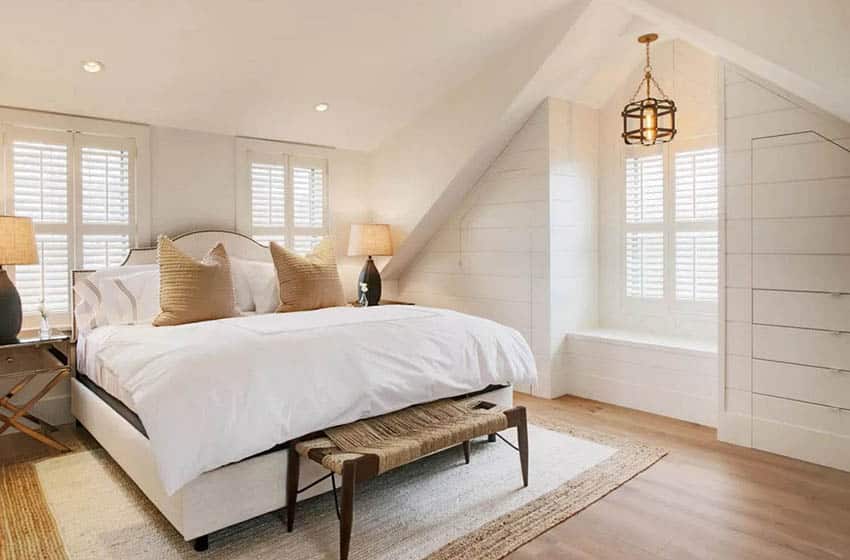
The dimensions of the room is the least workable feature, seeing as to change the size you would need some serious construction to make an adjustment. With that in mind it is important to get the right rug and bed size for the space you have available to you to determine the best placement.
Having the correct size can also help make the room appear larger or smaller, depending on the intent.
Area Rug Sizes for a Small Bedroom
For a small bedroom, your area rug’s placement can be at the side of your bed. We suggest choosing a carpet that’s large enough to nearly fill up the entire bedroom.
It will visually enlarge the small bedroom. Leave at least between 2 inches and 5 inches of bare floor between the material and the walls.
For a twin-size or full-size bed, use these general guidelines for area rugs in a small bedroom.
Note: Twin-size beds typically measure about 39 inches wide by 75 inches long. A twin XL measures 80 inches long.
Meanwhile, a full-size bed, or double bed, measures 54 inches wide by 75 inches long.
A 4-foot by 6-foot or a 5-foot by 8-foot area rug fits the bottom two-thirds of the bed.
A 6-foot by 9-foot area rug can cover the floor space of the bed, a bench at the foot, and a nightstand.
A 9-foot by 12-foot carpet can cover the floor space of two twin-size beds, two benches at the foot of each one, and one nightstand in the center of the two.
Small Room Rug Tips– Smaller rooms limit the options, leaving you with needing a relatively smaller rug. If you can select one that is a little undersized it can leave more of the flooring exposed, which can make the room appear a little bit more spacious.
If your small room has a twin bed, the recommended size is 6′ x 9′, with the rug positioned in front of the stands and extending beyond the foot of the bed.
Area Rugs for Medium Room Sizes
Medium, or average-sized room, opens up many options. One can incorporate small, large, or even multiple rugs coordinating with the furniture layout.
The best layout for a medium-sized room with a queen-sized bed is a 6′ x 9′ with the rug laid out in front on the bed stands and reaching past the foot of the bed.
Area Rug Sizes for a Large Bedroom
For large bedrooms, choose large rugs that fill up most of the room, but leave at least 8 inches of space between the edges of the carpet and the walls.
For a queen-size or king-size bed, use these guidelines to choose an area rug for a large bedroom.
Note: A queen-size bed measures 60 inches wide by 80 inches long. A king-size bed measures 76 inches wide by 80 inches long. A California king-size bed measures 72 inches wide by 84 inches long.
An 8-foot by 10-foot or a 9-foot by 12-foot area carpet can cover the floor space of two-thirds of a queen-size or king-size bed, but not including the nightstands.
A 12-foot by 15-foot carpet can cover the floor space of a California king-size bed, and this size area, including the nightstands.
If you have a queen-size and a king-size bed, the area rug should extend at least 18 inches to 24-inches from the sides and the foot.
Large Room Rug Tips– Larger rugs are typically recommended in larger spaces. This can make the room not so prone to echoes, and help prevent feeling cold by having the rug take up a larger portion of the space.
Another option with large rooms is selecting multiple rugs for rooms that are multi-functional. This can differentiate between the tasks or events associated with each area of the room, or call for attention at a certain spot.
The best size rug for a large room with a king sized bed is the 8′ x 10′ size. This rug layout provides ample coverage surrounding the bed and stretching from right in front of the bed stands to beyond the foot of the bed. – interior designer Savannah.
Read more about how to pick rug sizes here.
Rug Positioning Guide for the Bedroom
Rug Size to Use Under Bed
Typical Size – For a quick general decision when it comes to bedrooms rugs there are a few things to keep in mind. The length of a carpet should be roughly 18 to 24 inches longer on each side of a queen-sized bed. This should result in a 8 to 9 foot carpet in length.
When it comes to the width of the rug they should generally be about 5 feet wide. If you would like it to extend all the way to the nightstands it needs to be about 9 feet or more wide. Some common sizes used with queen sized beds are listed below.
4 x 6 rug – A 4 foot by 6 foot is relatively small, meaning it is best used in a set. It is also good for smaller spaces. This size is not great for right under a queen size, but instead as a pair on either side.
5 x 7 rug – A 5 foot by 6 foot is another small one, but it can be placed comfortably underneath a queen size. With the petite sizing of this covering it is commonly used in smaller spaces. There are no nightstands or shelves beside the bed as it could reflect the size of the floor covering and room negatively.
5 x 8 rug – Just a little larger than the above mentioned rugs, a 5 foot by 8 foot carpet gives a little more length, and offering a better scale to include nightstands or bedside tables.
With the shorter 5 feet width, this covering can go under the bed but cannot be placed under the nightstands. This is still in the small to medium size category. The size of the rug greatly affects the price.
6 x 9 rug – Getting into the mid sized rugs a 6 foot by 9 foot is best for average sized rooms, and are really good for queen sized beds in particular. These are large enough that the space can have dual nightstands, but the floor covering is not wide enough to go under them.
7 x 10 rug – A 7 foot by 10 foot is on the larger to medium side of the rugs and is the largest size recommended size to place underneath a queen sized bed. This has the optimal excess on each side to provide comfort from entering and exiting the bed.
8 x 10 rug – An 8 foot by 10 foot is a little big for a queen sized bed, but can still be incorporated in a larger bedroom. Two options for setup with this size can be to put the carpet under both of the nightstands and the bed or to leave a quarter of the frame without the carpet underneath.
9 by 12 rug – A 9 foot by 12 foot carpet is extremely big and can be great in situations where the flooring is less than ideal and one wants to keep it covered. These only fit in large rooms.
Read more about the different master bedroom sizes to clarify small, average and large bedroom measurements.
Type & Shape of Rugs
Our bedroom floor covering shape and placement tip is to do your homework before buying. So many factors come into getting the bedroom rug placement right, such as determining if you need a rectangular or square area carpet under your bed.
Here’s a breakdown of the different shapes available.
Runner – Runners are long in length and short in width, making them commonly placed on either side of the bed and/or at the end. These are great for smaller spaces and smaller budgets. These do not get placed under the bed.
Round: Round rugs are great for smaller rooms, as they can fill up the correct space needed for under a bed, which leaving open space in the rest of the room. These are best placed in the middle of the frame, and shouldn’t be more than 1 foot longer than the bed itself.
Square – Square rugs are pretty uncommon in bedrooms, as they do not fit proportionally with the length of a bed. They are welcome in larger rooms where the square can made larger to accommodate.
Rectangle – Rectangle rugs are the most common (and what sizes are all listed above) in bedrooms as well as queen sized bedrooms in particular. Rectangle rugs are usually placed perpendicular to the bed so that there is more space to step on the carpet.
Rug Material and Style
There is no doubt that a beautiful rug can set the tone of a bedroom. A boring bedroom can stylishly bring the decor pieces together and create a classic vibe in the space. Consider the function, rug material, and the style of the room.
Rug Material
Natural Fiber Rugs: There are different types of natural fiber rugs, such as jute, seagrass, and sisal. It has a chic look and gives off a warm organic look. Plus, these materials are very durable and suitable for a master bedroom or guest bedroom.
Synthetic Fiber Rugs: These types of rugs are made from nylon and polypropylene. They are fade-resistant and stain-resistant. It’s perfect if you have pets at home.
Wool Rugs: One of the most common rugs used in the bedroom due to its color-retentive, durability, and perfect for high traffic areas, such as the foot & sides of the bed.
Pile Height
We included the pile height, or how thick it is to help you have an idea of the different bedroom options.
Low pile rugs are easy to clean, are durable, and can withstand heavy traffic. Their styles are usually dense in texture, short, and tight. A perfect example would be flat weave rugs.
High pile rugs are opposite of low pile. They are difficult to clean, but they offer a plush style. They can instantly make the bedroom feel cozy and warm. They have loose and tall loops. A perfect example would be shag rugs. It’s perfect for layered floor covering styles.
Rug Pads and Maintenance
It’s important to learn how to care for your area rug so you can use it for a long time. Let’s be honest, rugs aren’t cheap, so learning these care tips and maintenance can be very handy!
Our top care tip is to place a pad underneath your rug. We mentioned placing a pad under the symmetrical split layout. An alternative is to use a double-sided carpet tape to keep the carpet from moving or shifting.
To make your rug look always new, you can remove the indentations with an ice cube treatment. Yes, let the ice cube melt on the indentation, then fluff up the fibers with your fingers. Pretty simple, right?
Bedroom floor covering placement can be confusing and quite complicated, but we hope this guide will help you get started on creating a cozy and serene bedroom space! Don’t forget your bedroom’s bed size and style when shopping for area rugs!
The area rug’s color should fit with the decor and style! Consider the lighting of the space, too! Good luck with furnishing your bedroom!
For more related designs see our gallery of bedroom layout ideas here.

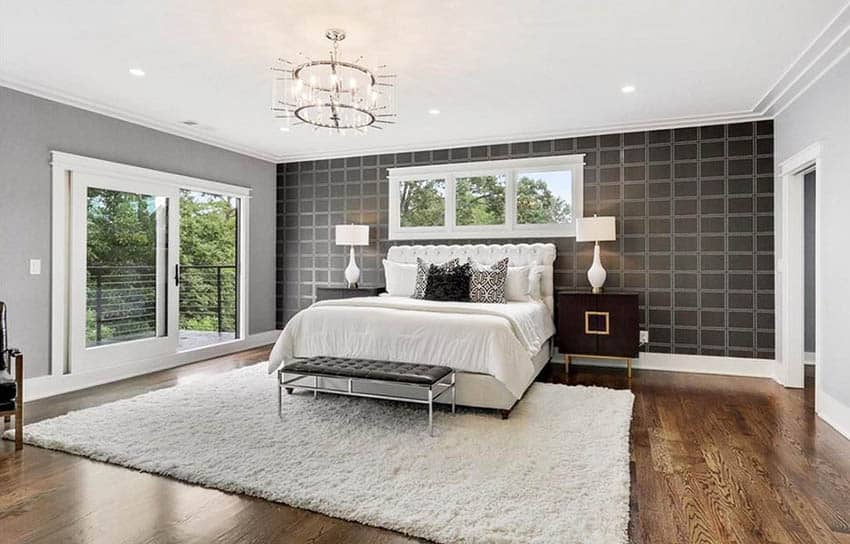
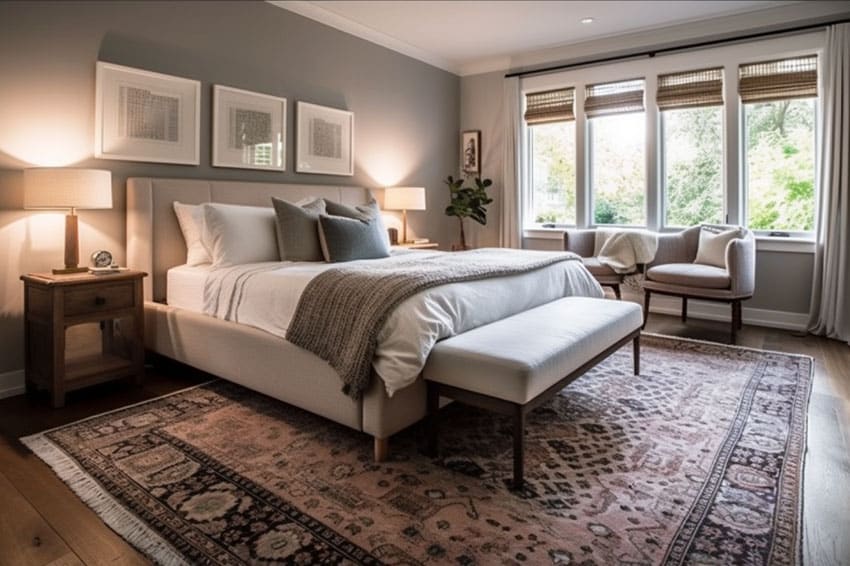
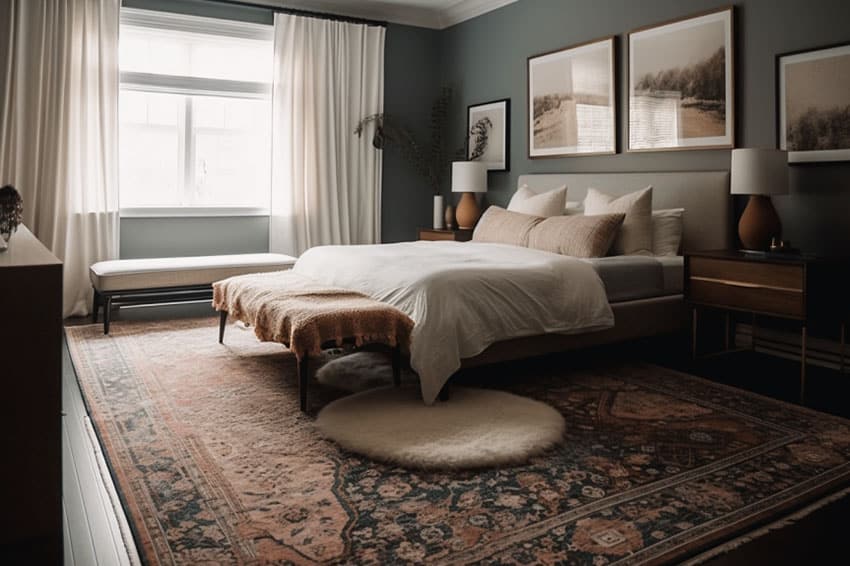
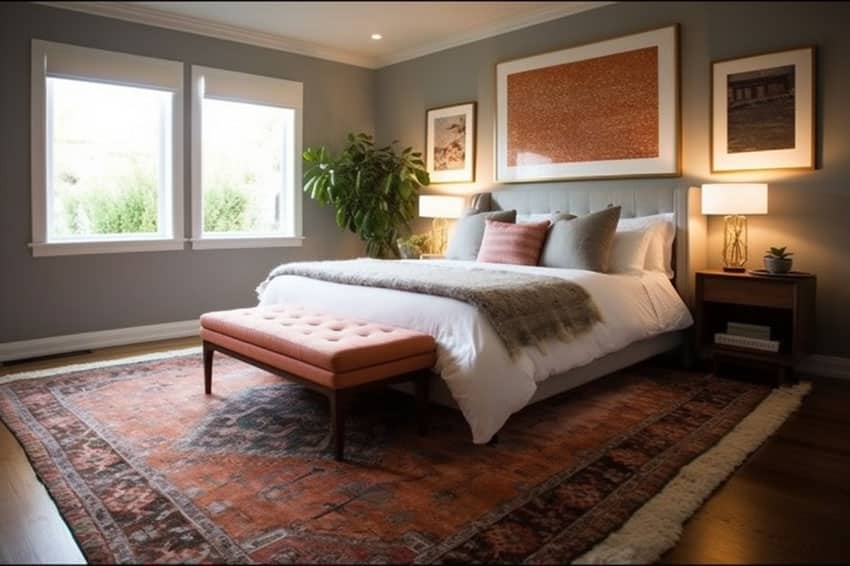
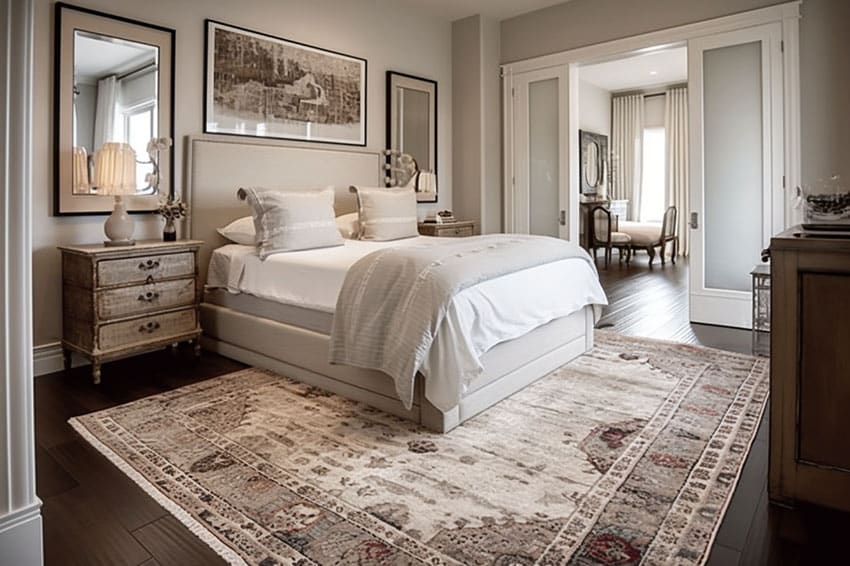
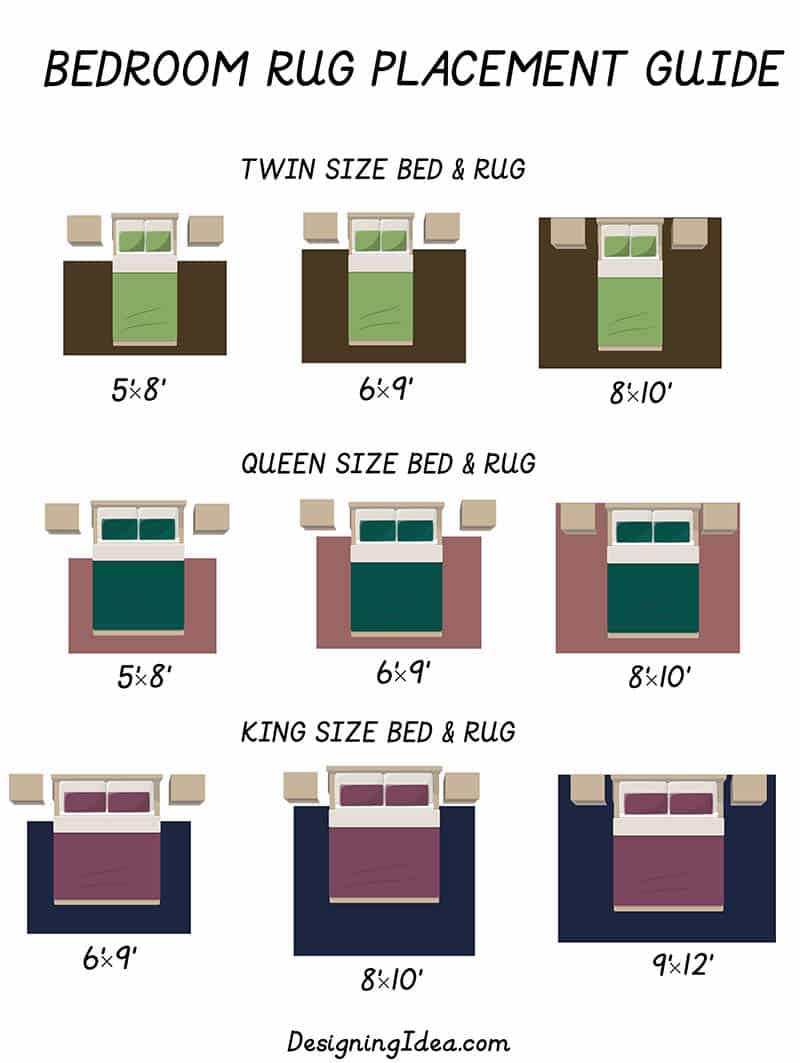
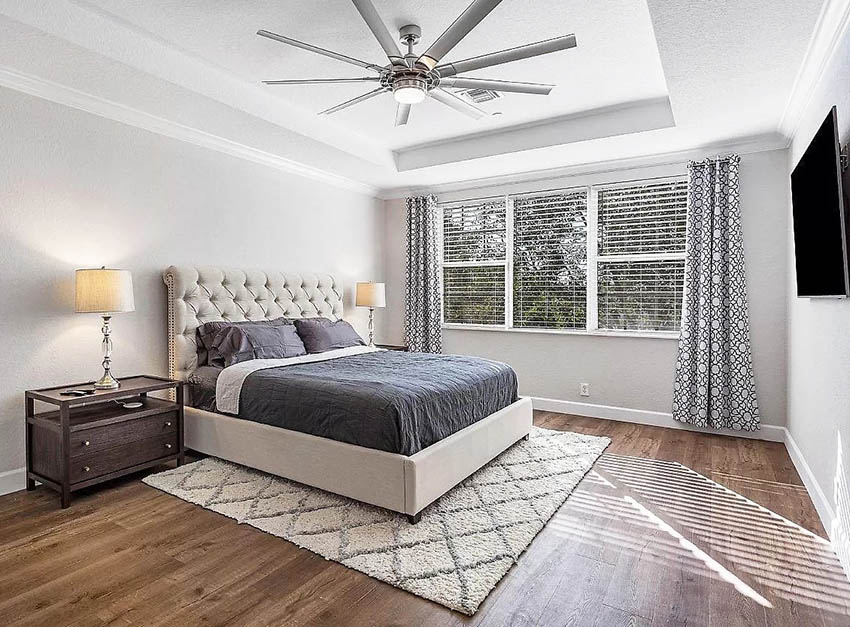
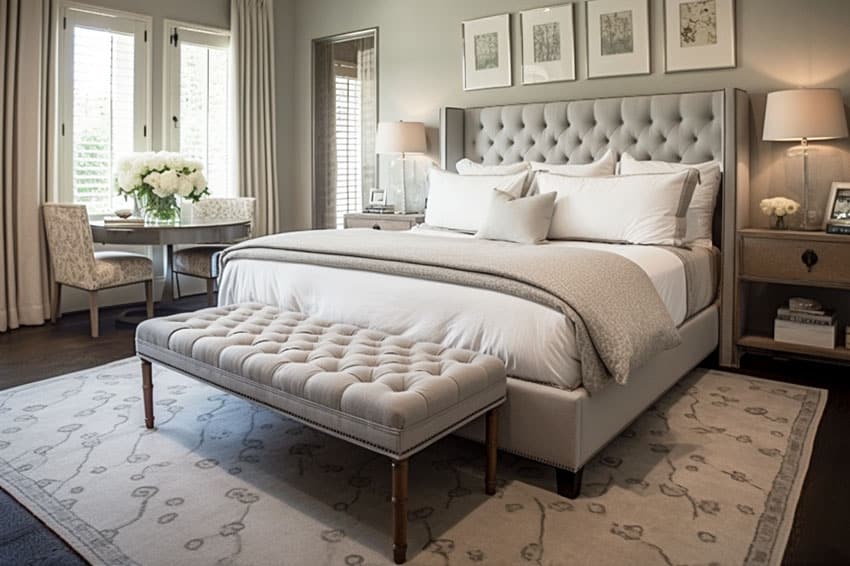
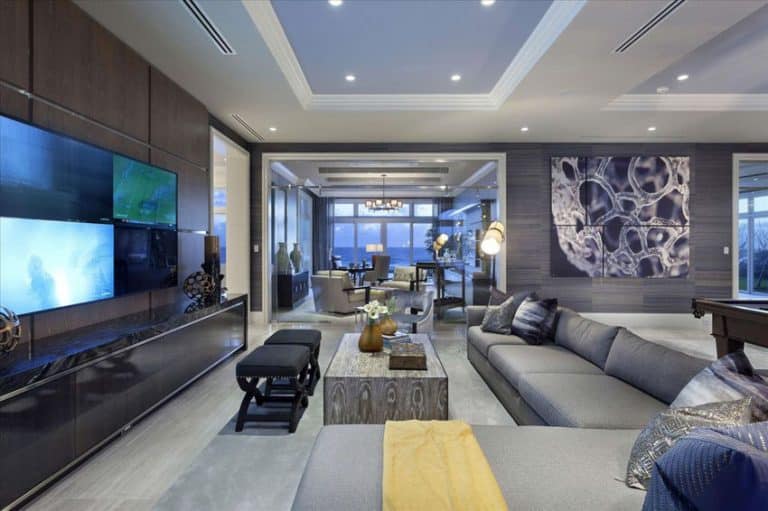
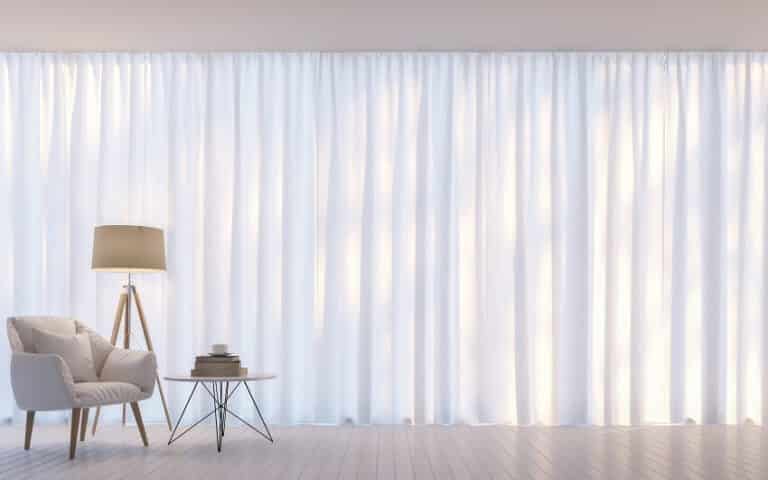
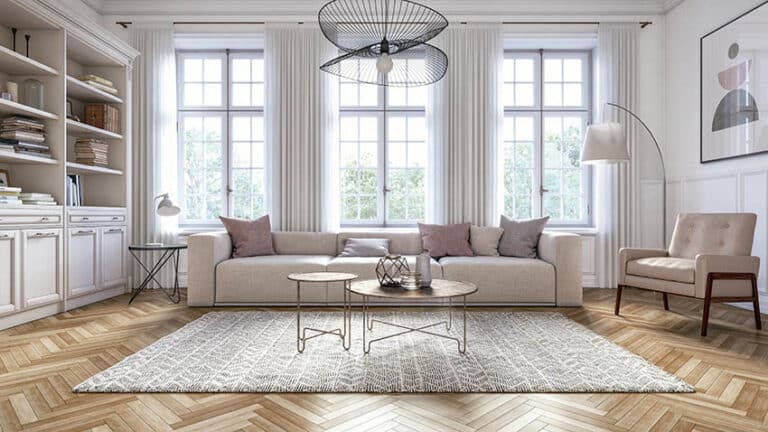
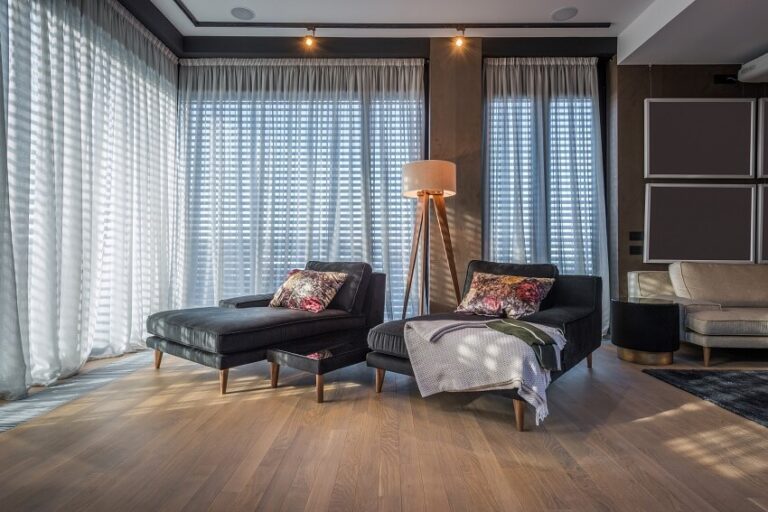
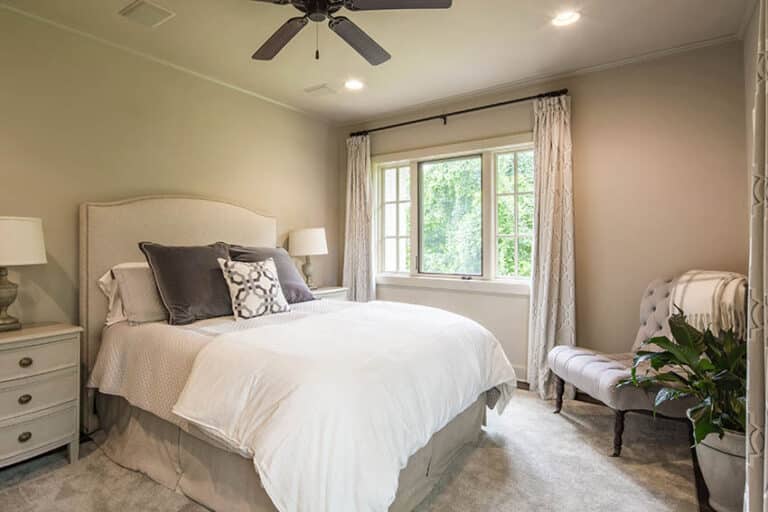
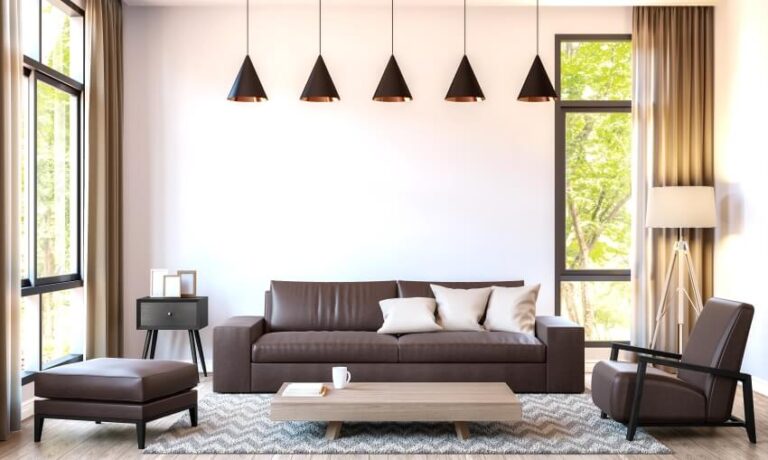
Great article except it would help if the author defined, by approximate measurement, what constitutes a small, medium it large sized bedroom.
Great idea, we’ve included a link to our article about small, average and large master bedroom dimensions for reference.